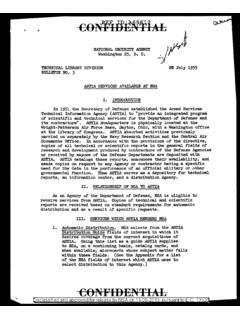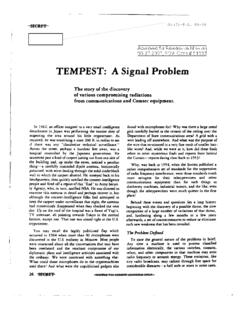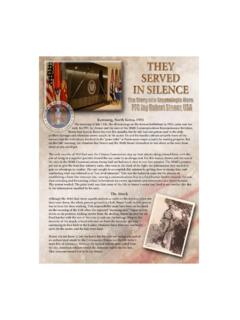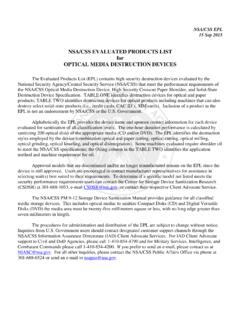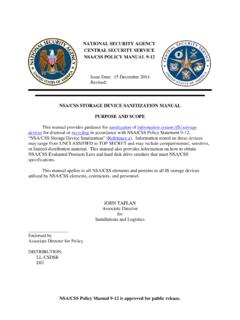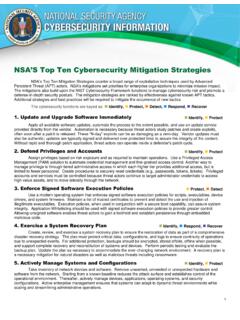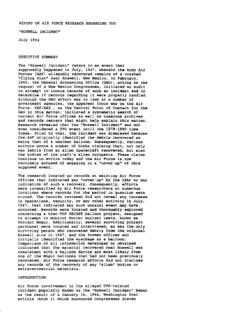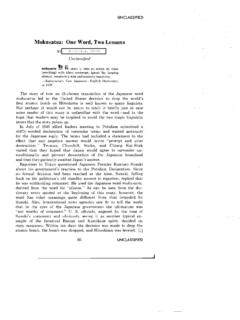Transcription of ELECTRONIC INTELLIGENCE (ELINT) AT NSA
1 ELECTRONICINTELLIGENCE (ELINT) AT NSAC over Photos: From top to bottom, US Air Force ad-vanced ELINT airborne collection platform; early GRAB satellite; Cold War ELINT signals analysis publication is distributed FREE by the National Security Agency. If you would like additional copies, please submit your request to:Center for Cryptologic HistoryNational Security Agency9800 Savage Road, Suite 6886 Fort George G. Meade, MD 20755-6886 ELECTRONIC INTELLIGENCE (ELINT) at NSAR ichard L. BernardCenter for Cryptologic HistoryNational Security Agency2009 This publication is a product of the National Security Agency history program. It presents a historical per-spective for informational and educational purposes, is the result of independent research, and does not necessarily reflect a position of NSA/CSS or any other US government is ELECTRONIC INTELLIGENCE (ELINT)?
2 ELINT is information derived primarily from ELECTRONIC signals that do not contain speech or text (which are considered COMINT).It is divided into major branches. One branch is Technical ELINT (TechELINT), which describes the signal structure, emission characteristics, modes of operation, emitter functions, and weapons systems associations of such emitters as radars, beacons, jammers, and navigational main purpose of TechELINT is to obtain signal parameters which can define the capabilities and the role that the emitter plays in the larger system, such as a ground radar locating aircraft, and thus lead to the design of radar detection, countermeasure, or counterweapons equipment.
3 The overall process, including operation of the countermeasures, is part of ELECTRONIC major branch is Operational ELINT (OpELINT), which concentrates on locating specific ELINT targets and determining the operational patterns of the systems. These results are commonly called ELECTRONIC Order of Battle (EOB). OpELINT also provides threat assessments, often referred to as tactical ELINT. OpELINT INTELLIGENCE products support military operational planners and tactical military commanders on the former third major branch of ELINT is the collection, processing, and reporting of foreign telemetry signals INTELLIGENCE (TELINT). TELINT is technical and INTELLIGENCE information derived from the intercept, processing, and analysis of foreign telemetry.
4 At one time Telemetry INTELLIGENCE was considered a branch of ELINT since TELINT (later to be called FISINT Foreign Instrumentation Signals INTELLIGENCE ) activities are closely related to TechELINT procedures and were conducted by all of the Department of Defense (DoD) military departments. TELINT is a critical source of performance information on foreign missiles 2and space vehicles while they are being developed and tested. TELINT can also provide much operational information on foreign satellites and space vehicles. ELECTRONIC INTELLIGENCE (ELINT) at the National Security Agency (NSA) did not have an easy start. When NSA was formed in 1952, consideration was given to including ELINT as well as COMINT as part of NSA s charter.
5 It is widely believed that Lieutenant General Ralph Canine, USA, Director of NSA at that time, felt that managing the DoD COMINT efforts would be enough of a challenge for NSA. This attitude toward ELINT was shared by the DoD military departments none wanted NSA to manage ELINT; each department was very content to manage its own interests in of Defense ELINT, however, was as much in need of coordination and management as COMINT. In particular, the effort badly needed a cohesive signal analysis and processing General Ralph Canine, USA, first Director of NSA3 The Start of Modern ELINTELINT had its start in World War II with the invention and use of radar by the Allies and the Axis.
6 The initial Allied ELINT efforts were started by the British; they are described in the book The Secret War by Dr. R. V. Jones. The US Army Air Forces had a keen interest in ELINT since most of the German radars at the time were used to target Allied bombers over Germany, and the air forces wanted to know as much about them as possible including how to evade, jam, or spoof the radars. During WWII the US military departments all used ELINT very effectively against German ground radars and against Japanese airborne, shipborne, and submarine radars. One of the early 1943 Army Air Force ELINT missions was flown by a B-24 over Kiska Island in the Aleutian Islands to electronically map the Japanese radars then on the island.
7 In 1944 large numbers of B-24s were outfitted with ELINT receivers, which were used to guide jamming of the German ground radars in after WWII, the USAF in Europe (USAFE) embarked on an aggressive TechELINT and OpELINT program, including establishing a solid and expansive cooperative program with several NATO 1952 the US DoD set up the Army-Navy Electronics Evaluation Group (ANEEG) to be housed at the Navy s Nebraska Avenue Naval Security Station (NSS) by coincidence the headquarters of NSA at the time staffed with about thirty people. The ANEEG had only informal coordinating collection powers, but it was both a centralized analysis point for processing and analysis of ELINT intercepts and a focal point for coordination of difficult ELINT analytic 1955, as ELINT processing problems grew, ANEEG was redesignated the National Technical Processing Center (NTPC), under the USAF Air Staff, and administratively was designated 4 AFCIN-Z; it was housed in Building 20 at the Naval Security Station in Washington, DC.
8 In addition to Army and Navy participation, the NTPC had key participants from the USAF and from the CIA. CIA at that time was operating the U-2 airborne reconnaissance program, and it led the integration of U-2 data into NTPC signal processing efforts. The U-2 had ELINT signal collection packages as well as photographic for NSA to Manage DoD ELINTS tarting in 1954, a number of presidential-level committees recommended that ELINT be brought under NSA s purview. Both the Mark Clark Subcommittee of the Hoover Commission in 1954 and the William O. Baker Committee in 1957 made such a recommendation. Dr. Baker was a major influence in having US ELINT efforts managed by NSA.
9 Strongly backed by President Eisenhower, the Baker Committee s efforts culminated in the issuance of National Security Council INTELLIGENCE Directive (NSCID) No. 6, Communications INTELLIGENCE and Electronics INTELLIGENCE , in early Security Station (NSS) at Nebraska Avenue inWashington, DC, home of the NTPC5 NSCID gave NSA many ELINT powers. Within DoD it was implemented in early 1959 by an updated 1955 DoD Directive and focused DoD top management review within DDR&E, soon to be headed by Dr. Eugene Fubini, a staunch supporter of ELINT and of having NSA manage DoD ELINT. It gave NSA (with certain exceptions) operational and technical control of all US DoD ELINT activities.
10 The directive made it quite clear that the Joint Chiefs of Staff, component commanders, and the military departments and services were to fully support these NSA-managed ELINT Management Begins at NSAOne of the first actions taken in response to the DoD ELINT directive in March of 1959 was to incorporate the National Technical Processing Center into the NSA Collection and Signal Analysis (COSA) organization as the Non-communications Signals Analysis and Processing Division. By 1959, NTPC had about 100 people. This signal processing and analysis group formed the core of the NSA effort at that of the DoD military departments and combat commands were not greatly enthusiastic about NSA s new responsibilities, and as a result many management problems and effective coordination procedures developed.
